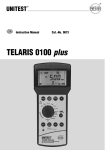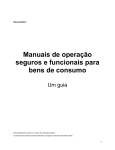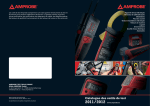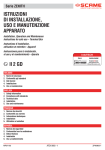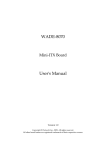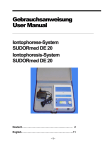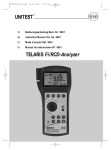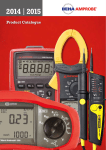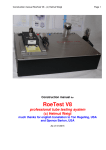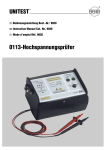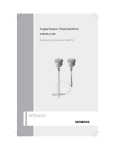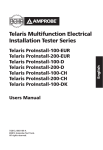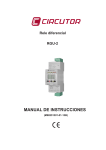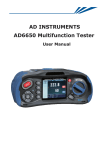Download TELARIS Fi/RCD-Analyzer UNITEST®
Transcript
UNITEST ® Instruction Manual Cat. No. 9061 ® TELARIS Fi/RCD-Analyzer 2 Contents ........................................................................................Page 1.0 Introduction / Scope of Supply ..............................................4 1.1 Model and Type Designation ..................................................4 1.2 Productdescription ................................................................4 2.0 Transport and Storage............................................................5 3.0 Safety Measures ....................................................................5 3.1 Appropriate Usage ................................................................7 4.0 Display / Operation Elements ................................................7 5.0 Carrying out Measurements ..................................................8 5.1 Voltage Measurement ............................................................9 5.2 General Information about RCD Tests ....................................10 5.2.1 Information regarding RCD testing ........................................10 5.2.2 Starting of RCD Test without RCD tripping, Function Vc/RE ......................................................................11 5.2.3 Starting RCD Test with RCD Tripping, Funtion tRCD/Vc..........12 5.2.4 Starting RCD Test with “RCD Tripping, Function Auto” ..........14 5.2.5 Starting Automatic RCD Test with RCD Tripping ....................16 6.0 Storing Measurement Data ....................................................17 6.1 Infrared Interface, send Measurement Data ..........................18 7.0 Deleting Stored Measurement Data / Display of All Memory Entries ................................................................18 8.0 Energy Management ..............................................................19 9.0 Maintenance ..........................................................................19 9.1 Cleaning ................................................................................19 10.0 Battery Replacement ............................................................19 11.0 Internal fuse ..........................................................................20 11.1 Indication in the display at defect fuse ..................................20 12.0 Calibration Interval ................................................................20 12.0 Technical Data ......................................................................21 24 month Warranty ..............................................................26 3 English Contents Introduction References marked on instrument or in instruction manual: Warning of a potential danger, comply with instruction manual. Reference. Please use utmost attention. Caution! Dangerous voltage. Danger of electrical shock. Continuous double or reinforced insulation complies with Category II. Warning of potential danger caused by accumulators and batteries. Conformity symbol, the instrument complies with the valid directives. It complies with the EMC Directive (89/336/EEC), Standards EN 50081 and EN 50082-1 are fulfilled. It also complies with the Low Voltage Directive (73/23/EEC), Standard EN 61010-1 is fulfilled. The instruction manual contains information and references necessary for safe operation and maintenance of the instrument. Prior to using the instrument (commissioning / assembly) the user is kindly requested to thoroughly read the instruction manual and comply with it in all sections. Failure to read the instruction manual or to comply with the warnings and references contained herein can result in serious bodily injury or instrument damage. 4 1.0 Introduction / Scope of Supply You have purchased a high quality measurement instrument of Ch. BEHA GmbH wich will allow you to carryout measurement over a long time period. The company Ch. BEHA GmbH is a member of the world -wide operating BEHA Group with its head office in Glottertal/Schwarzwald wich also houses our developement centre. The BEHA Group is a leading organisation for Test Measurement Instruments. 1.1 Model and Type Designation The identification label is located on the rear of the instrument. It contains the instrument serial number and product designation. When questions arise regarding the instrument, please always quote product designation and serial number. 1.2 Productdescription The UNITEST TELARIS FI/RCD Analyzer allows the testing of trip times of standard RCDs and selective RCDs using various residual currents. Additionally, the ground resistance and contact voltage can be measured. • Testing of trip times of standard RCDs and selective RCDs using various residual currents. • Testing of conventional, selective and all-current sensitive RC protection switches • Automatic RCD test (all RCD tests are carried out automatically) • Nominal residual currents may be selected: 10, 30, 100, 300, 500, and 1000mA • Automatic phase detection • Various curve shapes: Sine,1/2 wave rectified DC current, DC current • Start of measurement at 0° or 180° • Display of: trip time, trip current, contact voltage, ground resistance • Result assessment, result evaluation • Data memory for up to 100 measurement resutls • Infrared interface (RS232) for easy data transfer • Energy management with integrated auto power off function • Large, easily readable display • Built in compliance with EN 61557 Part 1 and 6, EN 61010-1, DIN VDE 0413 Part 1 and Part 6, Transport and Storage / Safety Measures 2.0 Transport and Storage Please keep the original packaging for later transport, e.g. for calibration. Any transport damage due to faulty packaging will be excluded from warranty claims. In order to avoid instrument damage, we recommend that batteries are removed when not using the instrument over a certain period of time. However, should the instrument be contaminated by leaking battery cells, you are kindly requested to return it to the factory for cleaning and inspection. Instruments must be stored in dry and closed areas. In the case of an instrument being transported in extreme temperatures, a recovery time of at least 2 hours is required prior to instrument operation. 3.0 Safety Measures The UNITEST Telaris FI/RCD Analyzer has been designed and checked in accordance with the safety regulations for Electronic test and Measurement Instruments EN 61010 and IEC 61010, and left our factory in a safe and perfect condition. The instruction manual contains information and references necessary for safe operation and maintenance of the instrument. In order to avoid electrical shock, the valid safety and VDE regulations regarding excessive contact voltages must receive the utmost attention when working with voltages exceeding 120V (60V) DC or 50V (25V)rms AC. The values in brackets are valid for limited ranges (as for example medicine and agriculture). Measurements in dangerous proximity of electrical installations are only to be executed when instructed by a responsible electrical specialist, and never alone. If the operator’s safety is no longer guaranteed, the instrument is to be put out of service and protected against use. The safety can no longer be guaranteed if the instrument (or leads): • shows obvious damage • does not carry out the desired measurements • has been stored for too long under unfavourableconditions • has been subjected to mechanical stress during transport. Avoid any heating up of the instrument by direct sunlight to ensure perfect functioning and long instrument life. Prior to usage, inspect the instrument and test leads for external damage. Prior to any operation, ensure that connecting leads used and instruments are in perfect condition. The instrument may only be used within the operating ranges as specified in the technical data section. The respective accident prevention regulations established by the professional association for electrical systems and equipment must be strictly met at all times. 5 English Scope of Supply 1 pc UNITEST TELARIS Fi/RCD-Analyzer 1 pc 3 pole test lead 1 pc Test lead with mains plug 1 pc Croccodile clamps 3 pc Test probe 1 pc Protective Holster 1 pc Carrying Case 6 pcs Battery 1.5V, type IEC LR6 (Size AA) 1 pc Instruction manual Display / Operation Elements 3.1 Appropriate Usage The instrument may only be used under those conditions and for those purposes for which it was built. When modifying or changing the instrument, the operational safety is no longer guaranteed. The opening of the instrument for fuse replacement, for example, may only be carried out by professionals. Prior to opening, the instrument has to be switched off and disconnected from any voltages. Any maintenance and calibration tasks may only be carried out by our repair service staff. The instrument may not be operated if the battery case is open. If the instrument is subjected to an extremely high electro-magnetic field, its functioning ability may be impaired. 6 4.0 Display / Operation Elements Display 1. Attention, warning symbol 2. Symbol “Limit” (Limitvalue) 3. Excess (breech) of contact voltage limit 4. Socket error 5. Battery status indication 6. Unit display 7. Display for selective RCD 8. Phase position nominal residual current 9. Contact voltage limit 10. Current type 11. Selected nominal residual current 12. Nominal residual current - multiplication factor 13. Symbol for memory entry 14. Measurement data display 15. Symbol for ramp function 16. Temperature overload, overheating of the instrument 17. AC voltage, display of mains voltage Operation Elements 18. LCD 19. Key "VC/UL" to select contact voltage limit 20. Nominal residual current selection 21. PE contact electrode 22. Key "Start" 23. Key "Current Type" 24. Key "Phase Position" for nominal residual current 25. Key "Store 26. Key "Send" 27. Key "Clear" 28. Battery case (instrument rear) 29. Infrared RS232 PC interface 30. Key - "Multiplication Factor" for nominal residual current 31. Function selection switch 32. Display key to select individual measurement results Carrying Out Measurements 5.0 Carrying out Measurements 1 2 5 4 3 FAT (Final Approval Test) measurements have to be carried out in compliance with the appropriate applicable standards. 17 6 16 15 7 180¡ I∆N: 2.5x 13 10 11 12 9 English 14 8 18 180¡ I∆N: 2.5x 32 20 Display VC / UL tRCD/Vc Vc/RE tRCD/Vc 19 20 21 31 22 23 24 30 29 Clear Send Store 25 28 27 26 7 Voltage Measurement 5.1 Voltage Measurement Prior to usage the test instrument and the test leads have to be tested for correct functioning. I∆N: Test leads and test probes may only be touched at the handles provided. The user must not touch the test probes. The measurement connectors may not be connected to external voltages exceeding 300 V AC or DC to avoid any instrument damage. Fig. 1 When changing the measurement function or parameter I∆N and UL parameters, the TELARIS Fi/RCD-Analyzer automatically switches to the voltage measurement function. Select measurement function using the function selection switch (31). Connect test lead /mains connection lead to the UUT, as described in figure 1 or 2. Read measurement data on the display. No data storing possible ! 8 I∆N: P Fig. 2 General Information about RCD Tests 5.2 General Information about RCD Tests The contact voltage UB and the trip time t required by the RCD to disconnect the subsequent current circuit from the mains represent important measurement units for the asessment of an RCD. The contact voltage represents the voltage present during an insulation error between two simultaneously touchable components. At a measuring circuit without probe, available voltages between PE and earth can influence the measurement. a) the maximum allowable value for the contact voltage (25V/50V) may not be exceeded within any system during tripping at nominal residual current. b) the RCD must trip within a time limit of 300ms. The task of an residual current device (RCD) consists in switching off a system within a defined time period after an error prior the contact voltage reaches the permissible limit value of 25V / 50V. The system testing should be started by carrying out a visual inspection, in particular of the protective earth connection. Before using the N-conductor as probe check that all neutral points have low ohm resistance to the main neutral line. A available voltage of the N conductor to the arth can influence the measurement. The measuring function uses the N-conductor as a probe. Check first the connection between the neutral point of the distribution system and earth before the test is started. A possible voltage between the N-conductor and earth may influence the measurements. Leakage currents by preconnected loads can influence the measuring 1. Within the IT system, the protective earth conductor doesnot have to be connected with the PEN but with the protective earth connection. 2. The protective earth conductor must be connected to the PEN prior to the RCD within the TN system. 3. An insulation measurement as described in Section 5.2 must be performed. In particular it must be proved, that there is no connection between N and PE following the RCD. 4. Proof regarding the low impedance connection of equipotential bonding conductors in compliance with Section 5.4 must be available. Attached loads or operating supplies which contains capacitors or circulating machines can elongate the trip time. Time-delayed residual current devices trip at nominal residual current within 130…500ms, for double nominal fault current within 60…200 ms. Such RCDs are implemented as main residual current protection devices (please refer to IEC 61008-1) and are marked with the symbol “ S ”. The protective earth must be free of external voltage for the RCD test. However if an extraneous voltage is present, the instrument only indicates the voltage VC having been generated by the measurement. The measurement interruption caused by excess of UL by VC is only generated by the actual voltage present between the neutral conductor (N) and the protective earth (PE). Any test and measurement procedures in circuits equipped with residual current devices should only be performed after having consulted the operator terminals (data processing systems, material processing, motors, etc.). Prior to testing, we recommend all loads are switched off as they could falsify the measurement result. 9 English For this reason, IEC 60364 prescribes that Starting of RCD Test 5.2.1 Information regarding RCD testing The instrument TELARIS RCD Analyzer allows the measurement of trip times for standard RCDs and selective RCDs for different residual currents. Additionally, the ground resistance and the contact voltage can be measured without RCD tripping. The additional ramp function allows determination of the exact residual current and trip time. The instrument is equipped with an automatic RCD function to carry out fully automatic RCD tests. Table 1 and 2 informs about the type of current to be selected and about multiplication factors of nominal residual current.The multiplication factors may not be selected within all measurement functions and are in these cases disabled for the user. The nominal residual current selection also allows selection of selective RCDs (not possible for RCD TEST I∆/ta/UB). When selecting the selective RCD, the symbol "S" (7) appears on the display. To carry out a complete socket test, the contact electrode PE (21) must be touched. If the symbol socket error (4) appears, a PE error is present. If many measurements are carried out interrupted only by short breaks, the built-in overtemperature protection of the RCD Analyzer might respond, and the thermometer symbol (15) appears on the display. Subsequent measurements can only be carried out, once the instrument has cooled down and the thermometer symbol has gone out, thus avoiding any instrument damage. Any tests at nominal residual currents 10mA / 30mA may be started even if the thermometer symbol is on, as these currents do not lead to a heating up of the instrument. I∆N: If the RCD trips during testing, the socket error symbol (4) is displayed. This symbol is also displayed if the RCD is not in order and an incorrect tripping has been caused! I∆N: I∆N: If the instrument is switched off using function selection switch or if the instrument automatically switches off due to the automatic power off function, the pre-set nominal residual current value is maintained. Parameters such as phase position (0°, 180°), current type (AC, DC Plus, DC) and the nominal residual current multiplication factor are reset to the standard (default) values (0°, AC, x1). 10 The "Attention Symbol" indicates that one measurement unit has exceeded a limit value. When calling up the measurement data using "Display" key (18), the "Limit" symbol (2) or "UB>UL" (3) appears for the respective measurement unit. Starting of RCD Test 5.2.2 Connect test lead / mains connection cable to test instrument. Connect test lead / mains connection cable to the UUT, as described in figure 1 or 2. Select desired measurement function Vc/RE using function selection switch (31). Set nominal residual current selection (20) to desired nominal current (depending on RCD). Select Limitvalue via contact voltage using key "Vc/UL" (19). Touch contact electrode PE (21). Note display. I∆N: Display at contact voltage English Starting of RCD Test without RCD tripping, Function UB/RE The contact voltage UB and the ground resistance RE are measured during this test by applying a current amounting to 40 % of the nominal residual current. The contact voltage displayed is extrapolated to nominal residual current I∆N or to double the nominal residual current I∆N for selective RCDs. If the symbol "Socket Error" (4) is displayed, a PE error is present. Display at earth resistance Press key "Start" (22). After successful test the display key (32) is used to switch between measurement result. Measurement results can be saved via pressing key “Store” (25). If the condition of a faulty socket is to be saved, first press key "Start" (22). Upon hearing the "Error Signal" press the key "Store" (25). If the RCD trip, the "Attention" symbol (1) and "Socket error" symbol (4) are displayed 11 Starting of RCD Test 5.2.3 I∆N: Display at RCD has tripped Starting RCD Test with RCD Tripping, Funtion tRCD/UB The contact voltage VC is measured during a test, by applying a current amounting to 40 % of the nominal residual current. The contact voltage displayed is extrapolated to nominal residual current I∆N or to double the nominal residual current I∆N for selective RCDs. Upon the examnation of RCDs a break of 30 sec is had betweeen pre-test and preliminary test. A possible reason could be: • incorrect selection of test current. • a residual current is present within the net to be tested, causing the RCD to trip early because it sums up with the test currents. • RCD faulty. The calculated contact voltage is displayed up to an votage of 70 V The measurement is interrupted if the contact voltage exceeds the set contact voltage limit. "Attention" (1) and "UB>UL" (3) appears on the display. I∆N: I∆N: 12 I∆N: 2 x Connect test lead / mains connection cable to test instrument. Connect test lead / mains connection cable to the UUT, as described in figure 1 or 2. Select desired measurement function tRCD/UB using function selection switch (31). Set nominal residual current selection (20) to desired nominal current (depending on RCD). Set phase position using key 0° / 180° (24). Set current type (23) and multiplication factor using key (30). Starting of RCD Test The current types and multiplication factors to be selected at set nominal residual current are listed in tables 1 and 2. The measurement is interrupted if the contact voltage exceeds the set contact voltage limit. "Attention" (1) and "UB>UL" (3) appears on the display. Select contact voltage using key "VC" (19). Touch contact electrode PE (21). Note display. If the symbol "Socket Error" (4) is displayed, a PE error or other socket error is present. After successful test the display key (32) is used to switch between measurement result tRCD and VC within the measurement value display. ms I∆N: Display at trip time (tRCD) English Press key "Start" (22). I∆N: Display at limit of contact voltage is exceed If the RCD does not trip within correct tolerance values (also refer to table 3), the "Attention" symbol (1) and "Limit" (2) are displayed besides measurement value tRCD. A possible reason could be: • incorrect selection of test current. • a residual current is present within the net to be tested, causing the RCD to trip early because it sums up with the test currents. • RCD faulty. Display at trip time >300 ms I∆N: I∆N: Display at contact voltage (VC) Measurement results may be saved pressing key Store (25). 13 Starting of RCD Test If the condition of a faulty socket is to be saved, first press key "Start" (22). Upon hearing the "Error Signal" press the key "Store" (25). 5.2.4 Starting RCD Test with “RCD Tripping, Function Auto” For this test, the trip current I of the RCD is measured. The contact voltage VC is measured during the preliminary test at a current of 40%I∆N. The RCD test is resumed after the successful preliminary test at a residual current, rising in steps of 10 % from 40 % I∆N until maximum 140 % I∆N. The presently active residual current is indicated on the display and in the event of the RCD tripping the trip time of the RCD is meausured. The contact voltage VC is evaluated for the trip current I . The method of the rising test current is not necessarily binding in compliance with VDE, however represents a useful aid during trouble shooting. Test and measurement instruments within networks being protected by RCDs should only be used after agreement with the final instrument user (DP systems, process technology, motors, etc.). Connect test lead / mains connection cable to test instrument. Connect test lead / mains connection cable to the UUT, as described in figure 1 or 2. Select desired measurement function (I /tRCD/VC) using function selection switch (31). Set nominal residual current selection (20) to desired nominal current (depending on RCD). No possibility to check selective RCDs. Set phase position using 0°/180° key (24) and current type by means of key (23). Select contact voltage using key "VC/UL" (19). Touch contact electrode PE (21). Note display. If the symbol "Socket Error" (4) appears a PE error is present. Press key "Start" (22). After a successful test, it is possible to select between measurement results trip current I<, trip time tRCD, and contact voltage VC in the display (14) using display key (18). I∆N: Display trip current I∆N: If the contact voltage VC already exceeds the preset contact voltage limit UL during the preliminary test, the measurement is disabled and the "Attention" symbol (1) and "UB>UL" (3) is displayed. I∆N: Display trip time 14 Starting of RCD Test I∆N: I∆N: Display contact voltage English The measurement results may be saved by pressing key Store (25). If the condition of a faulty socket is to be saved, first press key "Start" (22). Upon hearing the "Error Signal", press key "Store" (25). If due to the ramp current the contact voltage is exceeded, the measurement is interrupted and the current is displayed at the level at which the excess occurred. To make sure that the RCD is tripping correctly, a standard test (tRCD/VC) has to be carried out. Example: A correctly functioning RCD has a trip time of ">300ms" at 50% I∆N, whereas the trip time smaller than 300ms. When performing standard test at I∆N. If the RCD already trips at 50 % I∆N or not at all at a residual current value higher than 100 % I∆N, the RCD is faulty or the incorrect nominal residual current has been selected. The attention symbol (1) is displayed and the symbol for exceeding the limit (2) is indicated together with the trip current (tRCD) display If trip time tRCD of RCD exceeds 300ms, the measurement value for an trip time is displayed as ">300ms". The "Attention" symbol (1) is displayed and for trip time display, the symbol for overload (2) appears. I∆N: I∆N: 15 Starting of RCD Test 5.2.5 Starting Automatic RCD Test with RCD Tripping The TELARIS RCD Analyzer is equipped with a fully automatic RCD analysis. As a first step, during a preliminary test, the contact voltage VC is measured at a current of 40 % I∆N and extrapolated to the nominal current. Thereafter, various AC residual currents are generated and both trip time and contact voltage are verified. The user must only make sure to switch on RCD after tripping between the individual test programs. Then, the RCD analysis is automatically continued. I∆N: .5x After successful preliminary test the following is displayed (14): Connect test lead / mains connection cable to test instrument. Connect test lead / mains connection cable to the EUT, as described in figure 1 or 2. Select desired measurement function (Auto) using function selection switch (31). Set nominal residual current selection (20) to desired nominal current (depending on RCD). Select contact voltage using key "VC/UL" (19). Touch contact electrode PE (21). Note display. “Pr 1” equals “Pr 2” equals “Pr 3” equals If the symbol "Socket Error" (4) appears a PE error is present. “Pr 4” equals I∆N: .5x Press key "Start" (22). The measurement is interrupted if the contact voltage exceeds the pre-set contact voltage limit. The following symbols appear: "Attention (1), "UB>UL" (3) and "Err “Pr 5” equals “Pr 6” equals “*Pr 7” equals “*Pr 8” equals 0.5x I∆N 0°, RCD must not trip 0.5x I∆N 180°, RCD must not trip 1x I∆N 0°, RCD must trip within 300ms (S-Type 130 ... 500ms) (test-time 500ms) 1x I∆N 180°, RCD must trip within 300ms (S-Type 130 ... 500ms) 2x I∆N 0°, RCD must trip within 150ms (S-Type 60 200ms) 2x I∆N 180°, RCD must trip within 150ms (S-Type 60 ... 200ms) 5x I∆N 0°, RCD must trip within 40ms (S-Type 50 ...150ms) 5x I∆N 180°, RCD must trip wit hin 40ms (S-Type 50 ... 150ms) *function not to be executed at 500mA and 1000mA RCDs 16 Storing Measurement Data The RCD trips several times during measurement and has to be switched on again. Thereafter, the measurement is automatically continued and ends with the display "POS" or "Err" on the display (18). To interrupt the function AUTO, change the measurement range using the selection switch (31) Possibility to save. 180¡ Display at functioning RCD Carry out measurement. Store measurement result by pressing "Store" key (25). After successful storeing a short signal is audible and the symbol "M" (13) is displayed, also, the memory address number briefly appears. In the event of pressing the Store-key when the memory is full, the “M” Symbol blinks briefly and an error signal is heard I∆N: 2 x Display at faulty RCD "POS" is an abbreviation of positive and signifies that the RCD is functioning correctly. If "Err" (Error) is displayed, the measurement is immediately interrupted. "Err" indicates a defective RCD or that the contact voltage has been exceeded. The nominal residual current multiplication factor (12) together with the phase position of nominal residual current (9) indicates in which program the automatic test has been interrupted. The measurement results may be stored by pressing key Store (25). It is advised to store when using this range, as the Report Studio Software enables a detailed decoding of the measurement results. The data in the memory is maintained if instrument is switched off or during battery replacement. Double storing of a measurement is impossible ! Under certain, unintentional circumstances data may be lost or modified during electronic saving. CH. BEHA will not be held liable for financial and other loss being caused by data loss, wrong handling or any other reason. We recommand you to save and transmit the measurement results daily to your computer. In case of incidentals outer influences you can lose saved measurement sof the instrument. 17 English I∆N: 5x 6.0 Storing Measurement Data After successful measurement, it is possible to save measurement value by means of "Store” key (25). Alltogether, approximately 100 measurement values can be saved. Proceed as follows: Infrared Interface, send Measurement Data 6.1 Infrared Interface, send Measurement Data Additionally, all memorised measurement data may be transferred to the PC (data archive) by means of an Infrared Interface. For this purpose, the interface adapter and the Software "Report-Studio” (Cat. No. 1206) and Interface (Cat. No. 1157), available as an optional feature, are required. The data transfer procedure is fairly easy: Apply the Interface adapter to TELARIS Connect adapter cable to PC (COM 2) via 9pole D-sub plug (RS232). Call the "Report-Studio” Software (please refer to user manual "Report-Studio”). Select menu item "read data” or select the button "read data from measurement instrument” by mouse click. The message "send data” appears. Press key "Send" (26). Data transfer is carried out. After a few seconds all stored data is available for further processing in the PC. For further details, please refer to user manual "Report-Studio". 7.0 Deleting Stored Measurement Data / Display of All Memory Entries It is possible to delete data by using key „Clear" (27). Furthermore, it is possible to display the total number of measurement value entries on the display: Display of Total Number of Measurement Value Entries: Set measurement range selection switch (31) to one of the 5 measurements ranges. Briefly press „Clear” key (27). A short beep signal is audible. The total number of all measurement values that have been saved is now displayed. Delete Last Stored Measurement Value: Set measurement range selection switch (31) to one of the 5 measurement ranges. Briefly press „Clear” key (27). A short beep signal is audible and the number of the memorised measurement data is displayed.The total number of all stored measurement data is displayed.The display disappears after approximately 2 seconds. Now release the key „Clear” (27) to avoid deletion of all memory entries. Deleting the last measurement value can be repeated as often as required, as long as data is available within the memory. Deleting all Stored Measurement Values: Set measurement range selection switch (31) to one of the 5 measurement ranges. Press „Clear” key (27) for approx. 5 seconds. A beep signals are audible. The number of all stored measurement values is displayed. The last stored value is deleted after 2 seconds. After 5 seconds, all values are deleted. „0“ appears on the display. The memory is completely deleted, the „M" symbol in the display disappears. 18 Maintenance / Battery Replacement 9.0 Maintenance When using the instrument in compliance with the instruction manual, no special maintenance is required. 9.1 Cleaning If the instrument is dirty after daily usage, it is advised to clean it by using a damp cloth and a mild household detergent. Prior to cleaning, ensure that the instrument is switched off and disconnected from external voltage supply and any other instruments connected (such as EUT, control instruments, etc.). 10.0 Battery Replacement If the battery symbol appears in the display, proceed with battery replacement. Prior to battery replacement remove the instrument from all measurement circuits. The right order of the batteries is shown on the inside of the battery compartment. Batteries with reversed polarity can lead to instrument destruction. Furthermore, they may explode or ignite. Only use batteries as described in the technical data section type 6LR61. Switch off the instrument. Loosen screws on the instrument rear. Remove battery case cover (by slightly knocking the instrument in the palm of the hand). Remove discharged battery. Insert new battery by respecting the correct polarity. Replace battery case cover and tighten screws. Instrument is operational. Never use acid detergents or dissolvants for cleaning. 19 English 8.0 Energy Management Approximately 5 minutes after last key operation, the instrument switches off automatically (auto-poweroff). To switch the instrument on again, turn rotary switch from the „OFF" position to the desired function. If the batteries are almost completely discharged, the battery symbol (5) appears. The instrument continues functioning without necessarily respecting the specifications. If the batteries continue to be used and discharged, the instrument switches off at a point when the minimum battery voltage level is reached and may not be switched on again. Battery Replacement / Calibration Interval Never try to disassemble a battery cell. Never throw a battery into open flames as this could lead to an explosion. Never subject batteries to humidity. Please consider your environment when disposing of used batteries. They belong in a rubbish dump for hazardous waste. Generally speaking you may return your batteries to the point of sale. The appropriate regulations concerning return, recycling and disposal of used batteries must be respected at all times. If the instrument is not used over an extended time period, we recommend to remove the battery. In the event of instrument contamination caused by leaking battery cells, the instrument has to be returned for cleaning and verification to our factory. 11.0 Internal fuse The internal fuse protects the instrument from overload or wrong operation/use. The fuses can trigger, if tensions > 600 V AC/DC are connected to the instrument. The fuse is inside the instrument, the instrument must be opened for the exchange. The fuses can only be replaced by returning the instrument to the factory or to an authorized sales repair service. Exclusively use fuse of voltage, current and breaking capacity values in compliance with the technical data section. 20 11.1 Indication in the display at defect fuse If the instrument is correctly connected to the mains and before the measurement displays the symbols attention (1) and UB > UL (3), the internal fuse has blown. The fuse must be replaced and the measurement instrument then checked by returning the instrument to the factory or to an authorized sales repair service. 12.0 Calibration Interval To obtain the specified measurement result accuracy the instrument should be regularly calibrated by our after sales service. We recommend a calibration interval of one year. Technical Data 13.0 Technical Data 13.1 Tables wih test currents Table 1 Test Currents Function VC/RE, tRCD/VC, Auto (mA) I∆N UB/RE- x0.5 x1 x2 x5 Measurement: 1000 Prestest 4 12 40 120 200 400 ~ 5 3,5 15 50 5 10 14 10 20 28 20 50 10,5 15 30 42 30 60 84 60 150 212 150 35 50 70 50 100 141 100 200 283 200 500 707 500 150 105 150 300 424 300 600 849 600 1500 250 175 250 500 707 500 1000 500 1000 2000 English 10 30 100 300 500 Table 2 Ramp Currents Function I<, tRCD/VC (mA) I∆N 10 4-14 1,4-20 1-14 30 12-42 4,2 - 59 3-42 100 40-140 14-198 10-140 300 120-420 42-594 30-420 500 200-700 71-990 1000 400-1400 Table 3 RCD Trip Times for standard RCB´s Fi/RCD-Type Current Type Test Current prescribed I∆N I∆N Trip Time x0.5 0.5x - 2000ms, I∆N≥100mA: 500ms IEC61008-1 √ x1 1x <300ms 500ms IEC61008-1 √ 10mA/ x2 2x <150ms 150ms IEC61008-1 √ 30mA/ x5 5x <40ms 40ms IEC61008-1 √ 100mA/ Ramp 0.4x- 1.4x <300ms 300ms IEC61008-1 √ 300mA/ x0.5 0.35x - 2000ms, I∆N≥100mA: 500ms IEC61008-1 √ 500mA/ x1 1.4x <300ms 500ms IEC61008-1 √ 1000mA x2 2.8x <150ms 150ms IEC61008-1 √ x5 7x <40ms 40ms IEC61008-1 √ Ramp 0.1x- 1.4x <300ms 300ms IEC61008-1 √ x0.5 0.5x - 2000ms, I∆N≥100mA: 500ms 0664- Part 100 √ x1 1x <300ms 500ms 0664- Part 100 √ x2 2x <150ms 150ms 0664- Part 100 √ x5 5x <40ms 40ms 0664- Part 100 √ Ramp 0.1x- 1.4x <300ms 300ms 0664- Part 100 √ I∆N Current Type Test Time Standard Fi/RCD DIN VDE Analyzer 21 Technical Data Table 4 Trip times for selective RCB´s Fi/RCD-Type Current Type Current Type Test Current prescribed I∆N I∆N Trip Time x0.5 0.5x - 500ms IEC61008-1 √ x1 1x 130...500ms 500ms IEC61008-1 √ 100mA/ x2 2x 60...200ms 200ms IEC61008-1 √ 300mA/ x5 5x 50...150ms 150ms IEC61008-1 √ 500mA/ x0.5 0.35x - 500ms IEC61008-1 √ 1000mA x1 1.4x 130...500ms 500ms IEC61008-1 √ x2 2.8x 60...200ms 200ms IEC61008-1 √ x5 7x 50...150ms 150ms IEC61008-1 √ x0.5 0.5x - 500ms 0664- Teil100 √ x1 1x 130...500ms 500ms 0664- Teil100 √ x2 2x 60...200ms 200ms 0664- Teil100 √ x5 5x 50...150ms 150ms 0664- Teil100 √ I∆N Test Time Standard Fi/RCD Analyzer Table 5 Trip times for RCB´s with over curent protection Fi/RCD-Type I∆N Current Type Current Type Test Current prescribed Test Time Standard Fi/RCD I∆N I∆N Trip Time x0.5 0.5x - 2000ms, I∆N≥100mA: 500ms IEC61009-1 √ x1 1x <300ms 500ms IEC61009-1 √ 10mA/ x2 2x <150ms 150ms IEC61009-1 √ 30mA/ x5 5x <40ms 40ms IEC61009-1 √ 100mA/ Ramp 0.4x- 1.4x <300ms 200ms IEC61009-1 √ 300mA/ x0.5 0.35x - 2000ms, I∆N≥100mA: 500ms IEC61009-1 √ 500mA/ x1 1.4x <300ms 500ms IEC61009-1 √ 1000mA x2 2.8x <150ms 150ms IEC61009-1 √ x5 7x <40ms 40ms IEC61009-1 √ Ramp 0.1x- 1.4x <300ms 200ms IEC61009-1 x0.5 0.5x - 2000ms, I∆N≥100mA: 500ms √ x1 1x <300ms 500ms √ x2 2x <150ms 150ms √ x5 5x <40ms 40ms √ Ramp 0.1x- 1.4x <300ms 200ms √ 22 Analyzer √ Technical Data Table 6 Trip times for selective RCB´s with over curent protection Current Type I∆N Current Type Test Current prescribed I∆N I∆N Trip Time Test Time Standard Fi/RCD Analyzer x0.5 0.5x - 500ms IEC61009-1 √ (RCBO) x1 1x 130...500ms 500ms IEC61009-1 √ (100mA/ x2 2x 60...200ms 200ms IEC61009-1 √ 300mA/ x5 5x 50...150ms 150ms IEC61009-1 √ 500mA/ x0.5 0.35x - 500ms IEC61009-1 √ 1000mA) x1 1.4x 130...500ms 500ms IEC61009-1 √ x2 2.8x 60...200ms 200ms IEC61009-1 √ x5 7x 50...150ms 150ms IEC61009-1 √ x0.5 0.5x - 500ms √ x1 1x 130...500ms 500ms √ x2 2x 60...200ms 200ms √ x5 5x 50...150ms 150ms √ English Fi/RCD-Type Table 7 Trip times for impulse resistent RCB´s Fi/RCD-Type Current Type Current Type Test Current prescribed I∆N I∆N Trip Time Test Time Standard Fi/RCD x0.5 0.5x - IEC61008-1 √ x1 1x 10...300ms 500ms IEC61008-1 √ 10mA/ x2 2x 10...150ms 150ms IEC61008-1 √ 30mA/ x5 5x 10...40ms IEC61008-1 √ 100mA/ Ramp 0.4x- 1.4x 10...200ms 200ms IEC61008-1 √ 300mA/ x0.5 0.35x - IEC61008-1 √ 500mA/ x1 1.4x 10...300ms 500ms IEC61008-1 √ 1000mA x2 2.8x 10...150ms 150ms IEC61008-1 √ x5 7x 10...40ms IEC61008-1 √ Ramp 0.1x- 1.4x 10...300ms 200ms x0.5 0.5x - x1 1x 10...300ms 500ms √ x2 2x 10...150ms 150ms √ x5 5x 10...40ms √ Ramp 0.1x- 1.4x 10...300ms 200ms Analyzer 2000ms, I∆N≥100mA: 500ms 40ms 2000ms, I∆N≥100mA: 500ms 40ms 2000ms, I∆N≥100mA: 500ms 40ms IEC61008-1 √ √ √ 23 Technical Data Table 8 Fi/RCD-Type Current Type Current Type Test Current prescribed I∆N I∆N Trip Time x0.5 0.5x I∆N - x1 1x I∆N <200ms 500ms VDE 661 √ x5 5x I∆N <40ms 40ms VDE 661 √ 10mA/ x0.5 0.35x I∆N - 2000ms VDE 661 set to 0.5x I∆N¸ 30mA x1 1.4x I∆N <200ms 500ms VDE 661 √ x5 7x I∆N <40ms 40ms VDE 661 √ x0.5 0.5x I∆N - 2000ms set to 0.5x I∆N¸ x1 1x I∆N <200ms 2000ms √ x5 5x I∆N <40ms 40ms √ Test Time Standard Fi/RCD I∆N Test Time Standard Fi/RCD Analyzer 2000ms VDE 661 set to 0.5x I∆N¸ Table 9 Fi/RCD-Type Current Type Current Type Test Current prescribed I∆N I∆N Trip Time fixed x0.5 0.5x I∆N - 2000ms VDE 662 set to 0.5x I∆N¸ (SRCD) x1 1x I∆N <200ms 500ms VDE 662 - (10mA/ x5 5x I∆N <40ms 40ms VDE 662 - 30mA) x0.5 0.35x I∆N - 2000ms VDE 662 set to 0.5x I∆N¸ x1 1.4x I∆N <200ms 500ms VDE 662 VDE 662 - Analyzer x5 7x I∆N <40ms 40ms x0.5 0.5x I∆N - 2000ms set to 0.5x I∆N¸ x1 1x I∆N <200ms 500ms - x5 5x I∆N <40ms 40ms - Standardprüfung General Technical Data Display ............................................3 1/2 digit LCD Mains nominal voltage ....................230V/240V +10%-15% Mains nominal frequency ...............50/60Hz +/- 10% Reference-Range: ............................+17°C to 27°C, max. 70% rel. humidity Temperature-Range:........................0°C to 40°C Relative humidity: ............................max. 80% Height above MSL:...........................up to 2000m Battery type .....................................6 mignon 1.5V, Type AA, IEC LR6 (no storage batteries) Current consumption ......................approx. 15mA Battery life at average usage ...........approx. 2 years Auto power off ................................after approx. 5 min. Built in fuse......................................M 1,0A/250V, 5x20 mm Data memory ..................................approx. 100 measurements IR/RS232 interface .........................9600 Baud, 1 start bit, 8 data bits, even parity, 1 stop bit Degree of contamination .................2 Protection .......................................2, protective insulation, IP50 Overvoltage class ............................CAT II / 300V Dimensions (LxWxH) ......................235 x 105 x 70mm Weight ............................................650g (batteries included) 24 Technical Data Measuring Contact Voltage (UB) Measurement conditions ................40% I∆N Measurement time ..........................max 2000 ms,when exceeding limits, immediate cut-off Measurement range ........................0,6 ... 70,0 V bei I∆N 100, 300, 500, 1000mA ........................................................1...70 V bei I∆N 10, 30mA Resolution .....................................0,1 V at I∆N 100, 300, 500, 1000mA Tolerance ........................................-0%...+10% /+6 Digit Limits .............................................5V / 50V, contact voltage limit UL to be pre-selected English Measuring Ground Resistance (RE) Measurement conditions ...............40% I∆N Measurement time ..........................max. 2000 ms, when exceeding limits, immediate cut-off Range: ...............................................1...1999 Ω (at I∆N 100, 300, 500, 1000 mA) ...........................................................0,01...1,99 Ω (at I∆N 10, 30 mA) Resolution: ........................................1 Ω (at I∆N 100, 300, 500, 1000 mA) ...........................................................0,01 kΩ (at I∆N 10, 30 mA) Tolerance: .........................................±10%/ ±10 Digit (at I∆N 100, 300, 500, 1000 mA) ...........................................................±10%/ ±20 Digit (at I∆N 10, 30 mA) depends of contact voltage Measuring Trip Time tA: Measurement range ........................I∆N 10, 30, 100, 300, 500, 1000mA standard ........................................................100, 300, 500, 1000 mA Selektiv Test currents ..................................I∆N x0.5 / x1 / x2 / x5 (siee table 1) Test current type AC, .......................intermittent DC residual current ........................................................DC Phase position ................................. 0° / 180° Test current tolerance .....................0...-10% Measurement time ..........................see table 3, when exceeding limits, immediate cut-off. Measurement range ........................2...1999ms Resolution ......................................1ms Tolerance ........................................± (2%+2Digit) Limits .............................................25V / 50V, contact voltage limit UL to be pre-selected Measuring Trip Current (Ramp Funkction) Measurement ranges ......................10, 30, 100, 300, 500, 1000mA Standard, see table 2 Test currents .................................40% x I∆N...140% x I∆N, bei AC ........................................................10% x I∆N...140% x I∆N, bei pulsierendem Gleichfehlerstrom bzw. DC Phase position ................................0° / 180° Measurement time ..........................see table 3, when exceeding limits, immediate cut-off Display ............................................10% I∆N...140% I∆N Resolution ......................................10% I∆N Tolerance ........................................± 10% I∆N Display ............................................0...1999ms 25 Technical Data / 24 month Warranty Resolution ......................................1ms Tolerance ........................................± (2%+2Digit) Display ............................................0...50 V Resolution ......................................0,1 V bei I∆N 100, 300, 500, 1000mA ........................................................1V bei I∆N 10, 30mA Tolerance ........................................-0%...+10% /+6 Digit Limits .............................................25V / 50V, contact voltage limit UL to be pre-selected Auto function Measurement ranges .....................10, 30, 100, 300, 500, 1000mA idem ........................................................100, 300, 500, 1000 mA selective Test currents ..................................0.5 x I∆N, ........................................................1 x I∆N, ........................................................2 x I∆N, ........................................................5 x I∆N (not at I∆N = 500 / 1000 mA standard or S ), ........................................................automatic selection, also refer to table 1 Phase position ................................0° / 180°, automatic selection Measurement time ..........................see table 3, when exceeding limits, immediate cut-off Display ............................................O.K. / bad ( POS / Err ) Limits .............................................25V / 50V, contact voltage limit UL to be pre-selected Mains Voltage Range Measurement range ........................3...300V AC Tolerance ........................................+/-(3%+3 Digit) Frequency range .............................50/60Hz +/- 10% Internal resistance ...........................approx. 300kΩ Overvoltage protection ....................400V AC/DC 24 month Warranty UNITEST instruments are subject to strict quality control. However, should the instrument function improperly during daily use, your are protected by our 24 months warranty (valid only with invoice).We will repair free of charge any defects in workmanship or material, provided the instrument is returned unopened and untampered with, i.e. with undamaged warranty label.Any damage due to dropping or incorrect handling are not covered by the warranty. If the instrument shows failure following expiration of warranty, our service department can offer you a quick and economical repair. Subject to technical changes without notice! 26 Qualitätszertifikat • Certificate of Quality Certificat de Qualité • Certificado de calidad Die BEHA-Gruppe bestätigt hiermit, dass das erworbene Produkt gemäß den festgelegten Beha-Prüfanweisungen während des Fertigungsprozesses kalibriert wurde. Alle innerhalb der Beha-Gruppe durchgeführten, qualitätsrelevanten Tätigkeiten und Prozesse werden permanent durch e in QualitätsmanagementSystem nach ISO 9000 überwacht. Die BEHA-Gruppe bestätigt weiterhin, dass die während der Kalibrierung verwendeten Prüfeinrichtungen und Instrumente einer permanenten Prüfmittelüberwachung unterliegen. Die Prüfmittel und Instrumente werden in festgelegten Abständen mit Normalen kalibriert, deren Kalibrierung auf nationale und internationale Standards rückführbar ist. The BEHA Group confirms herein that the unit you have purchased has been calibrated, during the manufacturing process, in compliance with the test procedures defined by BEHA. All BEHA procedures and quality controls are monitored on a permanent basis in compliance with the ISO 9000 Quality Management Standards. In addition, the BEHA Group confirms that all test equipment and instruments used during the calibration process are subject to constant control. All test equipment and instruments used are calibrated at determined intervals, using reference equipment which has also been calibrated in compliance with (and traceable to) the calibration standards of national and international laboratories. Le groupe BEHA déclare que l´appareil auquel ce document fait référence a été calibré au cours de sa fabrication selon les procédures de contrôle définies par BEHA. Toutes ces procédures et contrôles de qualité sont régis par le systéme de gestion ISO 9000. Le groupe BEHA déclare par ailleurs que les équipements de contrôle et les instruments utilisés au cours du processus de calibrage sont eux-mêmes soumis à un contrôle technique permanent. Ces mêmes équipements de contrôle sont calibrés régulièrement à l´aide d´appareils de référence calibrés selon les directives et normes en vigueur dans les laboratoires de recherche nationaux et internationaux. El grupo BEHA declara que el producto adquirido ha sido calibrado durante la producción de acuerdo a las instrucciones de test BEHA. Todos los procesos y actividades llevados a cabo dentro del grupo BEHA en relación con la calidad del producto son supervisados permanentemente por el sistema ISO 9000 de control de calidad. Adicionalmente, el grupo BEHA constata que los equipos e instrumentos de prueba utilizados para la calibración también son sometidos a un permanente control. Estos equipos e instrumentos de prueba son a su vez calibrados en intervalos regulares valiéndose de equipos de referencia calibrados de acuerdo a directivas de laboratorios nacionales e internacionales. ® CH. BEHA GmbH Elektrotechnik - Elektronik In den Engematten 14 D-79286 Glottertal / Germany Tel. +49 (0) 76 84 / 80 09 - 0 Fax +49 (0) 76 84 / 80 09 - 410 e-mail: [email protected] internet: http://www.beha.com Quality Management System ISO 9001 Connemara Electronics Beha GmbH Industrial Park Carrigaline, Co. Cork Republic of Ireland Tel. (+353) 21 4919000 Fax (+353) 21 4910010 e-mail: [email protected] IQ N ET I.S./ISO 9002/EN 29002 Quality Management System AENOR Spain AFAQ France AIB-Vincotte Inter Belgium APCER Portugal BSI United Kingdom CSIQ Italy CQS Czech Republic DQS Germany DS Denmark ELOT Greece FCAV Brazil IRAM Argentina JQA Japan KEMA Netherlands KSA-QA Korea MSZT Hungary NCS Norway NSAI Ireland ÖQS Austria PCBC Poland PSB Singapore QAS Australia QMI Canada SFS Finland SII Israel JQA Japan SIQ Slovenia SIS-SAQ Sweden SQS Switzerland IQNet is represented in the USA by the following IQNet members: AFAQ, AIB-Vinçotte Inter, BSI, DQS, KEMA, NSAI and QMI 27 ® Re g . No . 3 3 3 5 11/2002 28 CH. BEHA GmbH Elektronik - Elektrotechnik In den Engematten 14 79286 Glottertal / Germany Tel.: +49 (0) 76 84 / 80 09 - 0 Fax: +49 (0) 76 84 / 80 09 - 410 Techn. Hotline: +49 (0) 76 84 / 80 09 - 429 internet: http://www.beha.com e-mail: [email protected] PTEB9061-00-RS




























